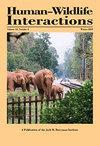机器学习作为野生动物管理和研究的工具:推特上野猪相关内容的案例
IF 0.9
4区 环境科学与生态学
Q4 BIODIVERSITY CONSERVATION
引用次数: 0
摘要
野猪(Sus scrofa)是一种非本地入侵物种,对牲畜、人类和野生动物造成相当大的损害并传播各种疾病。我们研究了最受欢迎的社交媒体微博平台Twitter,以展示如何利用社交媒体数据来调查对野猪的社会认同和情绪。在此过程中,我们采用了一种复杂的机器学习方法来调查:(1)与数据集相关的整体情绪,(2)通过用户个人资料描述的在线身份,以及(3)在线身份对情绪的影响程度。结果表明,在我们的数据集中,在线身份的最大群体是女性和从事新闻和媒体传播工作的人。虽然我们的大多数数据显示对野猪和其他相关搜索词的负面情绪,但与农业相关职业的用户有更有利的情绪。总的来说,本文是进一步研究野猪和其他入侵物种背景下社交媒体数据和社会身份使用的重要起点。本文章由计算机程序翻译,如有差异,请以英文原文为准。
Machine Learning as a Tool for Wildlife Management and Research: The Case of Wild Pig-Related Content on Twitter
Wild pigs (Sus scrofa) are a non-native, invasive species that cause considerable damage and transmit a variety of diseases to livestock, people, and wildlife. We explored Twitter, the most popular social media micro-blogging platform, to demonstrate how social media data can be leveraged to investigate social identity and sentiment toward wild pigs. In doing so, we employed a sophisticated machine learning approach to investigate: (1) the overall sentiment associated with the dataset, (2) online identities via user profile descriptions, and (3) the extent to which sentiment varied by online identity. Results indicated that the largest groups of online identity represented in our dataset were females and people whose occupation was in journalism and media communication. While the majority of our data indicated a negative sentiment toward wild pigs and other related search terms, users who identified with agriculture-related occupations had more favorable sentiment. Overall, this article is an important starting point for further investigation of the use of social media data and social identity in the context of wild pigs and other invasive species.
求助全文
通过发布文献求助,成功后即可免费获取论文全文。
去求助
来源期刊

Human–Wildlife Interactions
Environmental Science-Nature and Landscape Conservation
CiteScore
2.80
自引率
0.00%
发文量
0
审稿时长
11 weeks
期刊介绍:
Human–Wildlife Interactions (HWI) serves the professional needs of the wildlife biologist and manager in the arena of human–wildlife conflicts/interactions, wildlife damage management, and contemporary wildlife management. The intent of HWI is to publish original contributions on all aspects of contemporary wildlife management and human–wildlife interactions with an emphasis on scientific research and management case studies that identify and report innovative conservation strategies, technologies, tools, and partnerships that can enhance human–wildlife interactions by mitigating human–wildlife conflicts through direct and indirect management of wildlife and increased stakeholder engagement. Our intent is to promote a dialogue among wildlife professionals concerning contemporary management issues. As such, we hope to provide a repository for wildlife management science and case studies that document and share manager experiences and lessons learned.
 求助内容:
求助内容: 应助结果提醒方式:
应助结果提醒方式:


